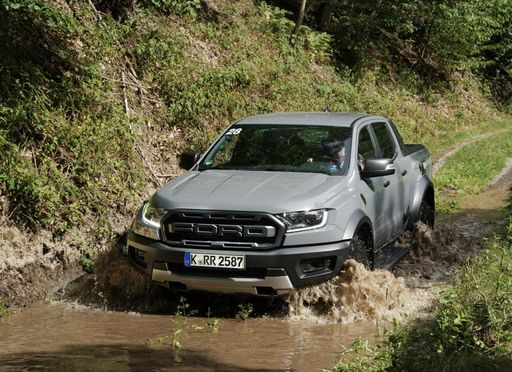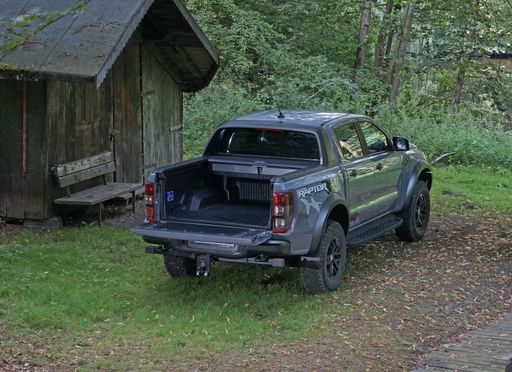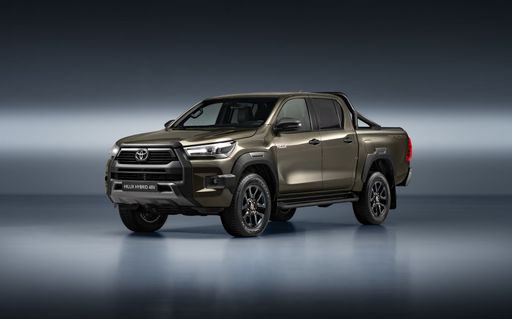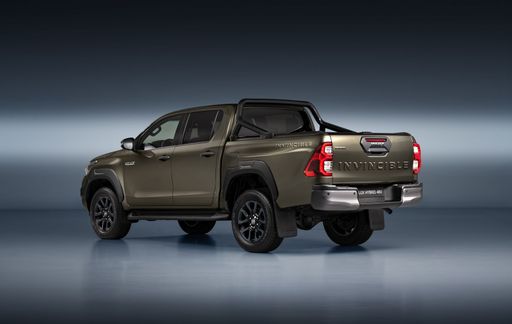The battle of the pickups is on, and two heavyweights—Ford Ranger and Toyota Hilux—are vying for supremacy. With impressive specifications, advanced technologies, and renowned reliability, both pickups have loyal followings. This comparison delves into their technical aspects and innovations, helping you decide which truck fits your needs best.
Ford Ranger vs Toyota Hilux – Differences & prices compared
Everyday use, family trips or long-distance drives – here’s where the differences show.
Discover whether Ford Ranger or Toyota Hilux fits your lifestyle better.
Powertrain Performance
The Ford Ranger showcases a robust lineup of engines that includes both diesel and petrol options, with power output ranging from 170 HP to an impressive 292 HP. With models equipped with a 3.0L V6, it churns out 600 Nm of torque, allowing for smooth acceleration. The Ranger also offers manual and automatic transmission options, making it flexible for various driving preferences.
On the other hand, the Toyota Hilux sticks to a 2.4L diesel engine delivering 150 HP and 400 Nm of torque. While it may trail behind the Ranger in sheer horsepower and torque, the Hilux remains a reliable choice, particularly for off-road enthusiasts. It features an automatic gearbox, keeping it user-friendly for everyday driving.
Acceleration and Speed
The Ford Ranger takes the edge in acceleration, with some variants reaching 0-100 km/h in just 7.9 seconds, depending on the engine choice. Its top speed reaches an impressive 190 km/h, reinforcing its performance credentials.
Conversely, the Hilux accelerates from 0-100 km/h in 12.8 seconds, with a top speed of 170 km/h. While not as swift as the Ranger, the Hilux is still designed to handle tough terrains effectively.
Fuel Efficiency and Emissions
When it comes to fuel consumption, the Ford Ranger averages between 8.4 to 10.6 L/100 km, depending on the engine variant. Its CO2 emissions range from 220 g/km to as high as 315 g/km, reflecting a broader spectrum of engine outputs.
The Hilux, contributing to environmental considerations, maintains a fuel consumption of 8.7 L/100 km and emits 227 g/km of CO2. For environmentally-conscious buyers, the Hilux’s slightly lower figures may be appealing, lending it a reputation for efficiency in its class.
Dimensions and Capacity
In terms of size, the Ranger measures between 5370 mm to 5420 mm in length, 1918 mm to 1968 mm in width, and varies in height between 1868 mm to 1884 mm. It boasts a payload capacity reaching up to 1,108 kg, making it an excellent choice for heavy-duty applications.
The Hilux, while slightly shorter at 5325 mm, features a width of 1855 mm and a height of 1815 mm. With a payload capacity of 1,025 kg, it is well-equipped for a variety of work tasks, though it offers less overall payload than the Ranger.
Innovative Features
Ford is known for incorporating cutting-edge technology in the Ranger. The latest models come with advanced driver-assistance features, such as adaptive cruise control, automatic emergency braking, and lane-keeping assist. The Ranger's infotainment system includes Ford's SYNC 4, which offers seamless connectivity with enhanced voice recognition.
The Toyota Hilux is no slouch either, featuring a solid infotainment system with smartphone integration capabilities. However, it tends to focus more on robust durability and reliability than ultra-modern tech features. Value seekers will also appreciate the Hilux's renowned durability and lower maintenance costs.
Conclusion: Which One is Right for You?
Your choice between the Ford Ranger and Toyota Hilux ultimately depends on your personal needs and preferences. If you prioritize sheer power, advanced technology, and versatility, the Ranger could be the perfect match. Yet, for those who value reliability, solid performance in challenging conditions, and good fuel efficiency, the Hilux remains a formidable contender in the pickup segment.
In the end, both vehicles represent the best of what modern pickups offer, and choosing one comes down to which qualities resonate with you more. Happy truck shopping!
Here’s where it gets real: The technical differences in detail
Costs and Efficiency:
Looking at overall running costs, both models reveal some interesting differences in everyday economy.
Ford Ranger has a barely noticeable advantage in terms of price – it starts at 37500 £, while the Toyota Hilux costs 39800 £. That’s a price difference of around 2234 £.
Fuel consumption also shows a difference: Ford Ranger manages with 3.10 L and is therefore clearly more efficient than the Toyota Hilux with 9.70 L. The difference is about 6.60 L per 100 km.
Engine and Performance:
Power, torque and acceleration say a lot about how a car feels on the road. This is where you see which model delivers more driving dynamics.
When it comes to engine power, the Ford Ranger has a clearly perceptible edge – offering 292 HP compared to 204 HP. That’s roughly 88 HP more horsepower.
In terms of top speed, the Ford Ranger performs slight better – reaching 190 km/h, while the Toyota Hilux tops out at 175 km/h. The difference is around 15 km/h.
There’s also a difference in torque: Ford Ranger pulls distinct stronger with 697 Nm compared to 500 Nm. That’s about 197 Nm difference.
Space and Everyday Use:
Beyond pure performance, interior space and usability matter most in daily life. This is where you see which car is more practical and versatile.
Both vehicles offer seating for 5 people.
In curb weight, Ford Ranger is minimal lighter – 2082 kg compared to 2085 kg. The difference is around 3 kg.
When it comes to payload, Toyota Hilux hardly perceptible takes the win – 1125 kg compared to 1108 kg. That’s a difference of about 17 kg.
Who wins the race?
The Ford Ranger proves to be leaves the rival little chance and therefore becomes our DriveDuel Champion!
Ford Ranger is the better all-rounder in this comparison.
 @ Ford Motor Company / Ford Media Center
@ Ford Motor Company / Ford Media Center
Ford Ranger
Ford Ranger
The Ford Ranger stands out in the pickup market with its robust build and versatile capabilities, making it a popular choice for both work and leisure. Its modern design is complemented by a well-equipped interior, providing comfort and advanced technology. Whether tackling challenging terrains or cruising through the city, the Ranger delivers a reliable and dynamic driving experience.
details @ Ford Motor Company / Ford Media Center
@ Ford Motor Company / Ford Media Center
 @ Ford Motor Company / Ford Media Center
@ Ford Motor Company / Ford Media Center
Toyota Hilux
The Toyota Hilux has long been celebrated for its remarkable durability and reliability, making it a favourite among those needing a robust vehicle for rugged terrains. Known for its unyielding performance, the Hilux combines practicality with a surprisingly comfortable driving experience, both on and off the road. With its distinctive design and advanced safety features, it continues to be a versatile choice for adventurers and professionals alike.
details @ Toyota Motor Corporation
@ Toyota Motor Corporation
 @ Toyota Motor Corporation
@ Toyota Motor Corporation
 @ Ford Motor Company / Ford Media Center
@ Ford Motor Company / Ford Media Center
|
 @ Toyota Motor Corporation
@ Toyota Motor Corporation
|
|
|
|
Costs and Consumption |
|
|---|---|
|
Price
37500 - 71900 £
|
Price
39800 - 56200 £
|
|
Consumption L/100km
3.1 - 13.8 L
|
Consumption L/100km
9.7 - 10 L
|
|
Consumption kWh/100km
-
|
Consumption kWh/100km
-
|
|
Electric Range
42 km
|
Electric Range
-
|
|
Battery Capacity
11.80 kWh
|
Battery Capacity
-
|
|
co2
70 - 315 g/km
|
co2
253 - 264 g/km
|
|
Fuel tank capacity
80 L
|
Fuel tank capacity
80 L
|
Dimensions and Body |
|
|---|---|
|
Body Type
Pickup
|
Body Type
Pickup
|
|
Seats
2 - 5
|
Seats
4 - 5
|
|
Doors
2 - 4
|
Doors
2 - 4
|
|
Curb weight
2082 - 2511 kg
|
Curb weight
2085 - 2295 kg
|
|
Trunk capacity
-
|
Trunk capacity
-
|
|
Length
5370 - 5420 mm
|
Length
5325 mm
|
|
Width
1918 - 1968 mm
|
Width
1855 mm
|
|
Height
1868 - 1922 mm
|
Height
1810 - 1815 mm
|
|
Max trunk capacity
-
|
Max trunk capacity
-
|
|
Payload
676 - 1108 kg
|
Payload
915 - 1125 kg
|
Engine and Performance |
|
|---|---|
|
Engine Type
Diesel, Petrol, Plugin Hybrid
|
Engine Type
Diesel MHEV, Diesel
|
|
Transmission
Manuel, Automatic
|
Transmission
Automatic, Manuel
|
|
Transmission Detail
Manual Gearbox, Automatic Gearbox
|
Transmission Detail
Automatic Gearbox, Manual Gearbox
|
|
Drive Type
All-Wheel Drive
|
Drive Type
All-Wheel Drive
|
|
Power HP
170 - 292 HP
|
Power HP
150 - 204 HP
|
|
Acceleration 0-100km/h
7.9 - 12.1 s
|
Acceleration 0-100km/h
-
|
|
Max Speed
180 - 190 km/h
|
Max Speed
170 - 175 km/h
|
|
Torque
405 - 697 Nm
|
Torque
400 - 500 Nm
|
|
Number of Cylinders
4 - 6
|
Number of Cylinders
4
|
|
Power kW
125 - 215 kW
|
Power kW
110 - 150 kW
|
|
Engine capacity
1996 - 2993 cm3
|
Engine capacity
2393 - 2755 cm3
|
General |
|
|---|---|
|
Model Year
2022 - 2025
|
Model Year
2024 - 2025
|
|
CO2 Efficiency Class
G, B
|
CO2 Efficiency Class
G
|
|
Brand
Ford
|
Brand
Toyota
|
What drive types are available for the Ford Ranger?
The Ford Ranger is offered with All-Wheel Drive.
The prices and data displayed are estimates based on German list prices and may vary by country. This information is not legally binding.
